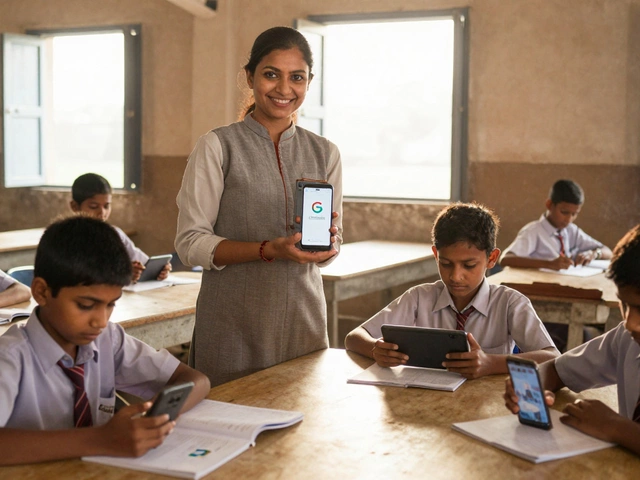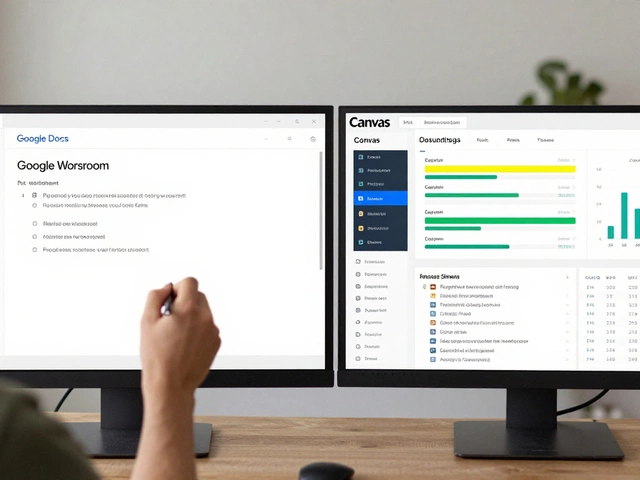Getting stuck after 'Hello, how are you?' when you're learning English? You’re not alone. Most platforms brag about lots of lessons, but the truth is, speaking fluently takes more than just ticking off grammar points. If your goal is to sound natural and confident, picking the right platform matters way more than you might think.
Here’s something that messes with almost everyone: you might ace the writing and listening parts, but freeze when it comes time to speak. Why? Because you’re not talking out loud enough, or the feedback you get isn’t actually helpful. So, if you’re serious about real conversations—think interviews, travel, making friends—then you need a platform that puts speaking right at the center.
Instead of wasting time on shiny-but-shallow apps, you want something that actually forces you to talk, make mistakes, and try again. Bonus points if you can get native speakers or real-time corrections. Seriously, the fastest progress usually comes from saying stuff out loud, not just staring at vocab flashcards.
- Why Choosing the Right Platform Matters
- Live Speaking vs. AI Conversations: What Works?
- Platforms Everyone Talks About (And If They Deliver)
- Hidden Gems: Under-the-Radar Tools That Work
- Tips for Getting Real Results, Fast
- Making the Most of Your Chosen Platform
Why Choosing the Right Platform Matters
Picking the right place to learn English makes a huge difference in how quickly you speak it with confidence. There are more choices than ever—live tutors, AI chat, group classes, and even platforms full of quick-bite videos. But not all of them work the same way or deliver what they promise.
Research from Cambridge University in 2022 found that people who practiced speaking for at least 30 minutes three times a week improved their fluency almost twice as fast as those who didn’t. The catch? Only certain platforms actually provided enough real speaking practice. Others focused way too much on quizzes or passive listening.
Here’s what to keep an eye out for when picking a platform:
- English speaking should be front and center—not an afterthought.
- Live conversation practice is way more effective than just listening to recordings or matching words to pictures.
- Quality feedback from real humans helps iron out mistakes a lot faster than automated corrections.
- Some apps pile on the grammar rules, but don’t push you to talk. Steer clear if talking out loud isn’t a clear focus.
Let’s get real with some numbers so you know what actually helps:
| Feature | How Much It Boosts Fluency |
|---|---|
| Live tutor sessions (30 min, 3x/week) | +45% faster improvement (over 6 months) |
| AI-only chat practice | +20% improvement |
| Group discussion with feedback | +35% improvement |
| Only grammar/video lessons | +10% improvement |
So, if you want to make your English actually work in the real world, don’t settle for a platform that just drills you on verbs or makes you memorize endless vocabulary. Give yourself the best shot with a tool that gets you talking, corrects you, and helps you build real confidence every time you log in.
Live Speaking vs. AI Conversations: What Works?
If you want to speak English fluently, you’ve basically got two main choices right now: live speaking with real people, or chatting with AI bots. Both ways have totally different vibes, pros, and drawbacks.
Live speaking means connecting with tutors, language partners, or even small groups where everyone gets a chance to talk. You can ask follow-up questions, get instant feedback, and hear real slang or expressions. Apps like italki, Cambly, and Preply run on this system. The real beauty is the unpredictability—you never know what someone will ask or how they’ll say it. That’s how real-life conversations work, so there’s no better practice if your goal is fluent English.
AI conversations have exploded this year. Duolingo, Speak, and Elsa all use artificial intelligence to give you something like human chat—minus the awkward silences. You get unlimited practice and zero judgement if you mess up. Plus, AI can score you in real time on pronunciation and grammar, so you always know exactly what went wrong.
| Platform Type | Pros | Cons | Avg. Cost (per month) |
|---|---|---|---|
| Live Speaking | Actual conversations, real-world feedback, exposes you to accents | Can be expensive, needs scheduling, can feel intimidating | $40 - $150 |
| AI Conversations | Practice anytime, tracks your progress, usually cheaper, no social anxiety | Sometimes robotic, lacks spontaneous real-world language | $7 - $30 |
Here’s a tip: If you can, mix both styles. Use AI bots for daily drills and to just get talking, but book at least one human session each week to battle nerves, pick up natural phrases, and get corrected in ways a bot might miss.
One Harvard study from late 2023 actually showed that learners who practiced with live teachers AND AI together improved their speaking confidence twice as fast as those who only did one or the other. So if you want that fast track, don’t stick to only one way.
Platforms Everyone Talks About (And If They Deliver)
There’s no shortage of English learning platforms out there, but only a handful get all the buzz. The big names—think Duolingo, Cambly, Preply, italki, and Babbel—are everywhere. But do these giants actually help you speak English fluently or just rack up points?
Duolingo is the king of gamified learning. It’s fun, it’s free, and everyone’s tried it. But here’s the catch: it’s heavy on reading and filling in blanks, pretty light on real speaking. Yes, you’ll repeat some phrases, but you don’t get real conversations or corrections from humans. It’s a nice warm-up, not a real workout for your speaking skills.
Cambly does things differently. You jump straight into talking with native speakers through live video calls. No lesson plans, no pressure—just conversations. That’s awesome for confidence and for anyone wanting feedback in real time. The downside? It can get pricey if you use it a lot, and the lesson quality can depend on which tutor you pick.
Then there’s italki and Preply. Both connect you to thousands of tutors for private 1-on-1 lessons. What’s cool is you can filter by price, accent, or even specific skills (like business English). Unlike Cambly, you get more structured lessons—plus the freedom to just chat if you want. If you’re someone who learns best with a regular teacher, these two are solid options. But, again, you have to be picky about who you book, since every tutor has their own style.
Finally, Babbel claims you can learn to speak in just three weeks. But in reality, it’s mostly listening, reading, and some pronunciation exercises. For total beginners, it gets you started, but don’t expect deep conversations with real people here.
Here’s a quick breakdown of what you actually get with these big platforms:
| Platform | Main Focus | Live Speaking? | Native Tutors? | Price Range (USD) |
|---|---|---|---|---|
| Duolingo | Gamified lessons | Very limited | No | Free / Premium $7/month |
| Cambly | Live chats | Yes | Yes | $25–$85/month |
| italki | 1-on-1 tutoring | Yes | Yes | $5–$40/lesson |
| Preply | 1-on-1 tutoring | Yes | Yes | $5–$30/lesson |
| Babbel | Self-study courses | Very limited | No | $13–$20/month |
Here’s the big takeaway: If your main goal is just to get talking—like actually speaking out loud and having someone help you improve—platforms built around live tutors (Cambly, italki, and Preply) are way more useful. Apps like Duolingo and Babbel are good for vocab and practice on the go, but they won’t get you comfortable in real conversations, especially if you get nervous or stuck when it’s your turn to talk.

Hidden Gems: Under-the-Radar Tools That Work
If you peek outside the usual crowd of big-name platforms, you’ll find some real underdogs doing a killer job helping people speak English. A few of these tools aren’t all over social media, but their die-hard users swear by the results. Let’s break down why folks keep these sites bookmarked.
English speaking is the bottom line for most learners, and that means less passive scrolling, more actual talking. Speechling, for example, puts your speaking front and center. You record your answers, real coaches listen and respond with voice feedback. It’s seriously personal—nothing is auto-graded by robots. Plus, you don’t need to schedule a lesson.
- Speechling: Free to start, unlimited recordings, feedback in under 24 hours. Their paid plan is $29.99/month, which is cheaper than most private lessons.
- Tandem: With over 10 million users, it connects you to language partners from around the world, so you’re literally talking to real people, not an algorithm. Free plan is decent; a Plus version (about $7/month) lets you filter for serious learners.
- italki Community: Skip the paid teacher—hop into the Community section and connect for language exchanges. You can do text, audio, or straight-up video calls.
Table comparing some quick facts and what these platforms are best at:
| Platform | Main focus | Best for | Monthly price (USD) |
|---|---|---|---|
| Speechling | Speaking + Coach Feedback | Busy folks wanting feedback | Free / $29.99 |
| Tandem | Language Exchange | Meeting real talk partners | Free / ~$7 |
| italki Community | Language Exchange + Practice | All levels, interactive | Free |
Want more tips? Here’s how users get the best value from these:
- On Speechling, don’t just do the daily exercises—record yourself answering questions about your actual day. Coaches spot mistakes you don’t notice.
- On Tandem, screen your partners. Pick someone active and with similar goals—conversations move faster, and you’re not left waiting for replies.
- With italki Community, start with voice notes before hopping on live calls. It’s way less awkward and builds up your confidence.
No one’s getting perfect overnight, but if you want something different from the standard Duolingo drills, these platforms are worth your time. Explore a few, see which interface clicks, and stick with the one you don’t dread opening.
Tips for Getting Real Results, Fast
If you want to speak English like you actually mean it, you need more than just regular practice. You need smart practice. Tons of research shows that active speaking—not passive watching or just reading—makes the biggest difference. The best platforms for English speaking always get you talking, not just listening.
- Talk Every Day (Even if It's Short) – A 2023 survey by Babbel showed that users who practiced speaking daily, even just 10 minutes, were twice as likely to break past that "awkward silence" stage in under two months.
- Record Yourself – You’ll catch your own mistakes way faster when you playback recordings. Some platforms like italki and Cambly let you record and review your speaking sessions, which is a huge boost.
- Don't Dodge Feedback – Honest correction feels weird at first, but it’s gold. Studies from Duolingo’s research group found users who got live correction improved 30% faster than those who only used automated lessons.
- Copy Native Speakers – There's a reason kids pick up slang so fast: they copy what they hear. Pause short videos or podcast clips, imitate the way real people talk, not robots.
- Mix It Up – Chat with different people, cover new topics, switch up your speaking partners or tutors. Sticking to the same script or talking only about "work" makes your progress stall.
Here’s a quick stat roundup comparing daily speaking and other learning styles:
| Method | Avg. Time to Conversational Fluency |
|---|---|
| Daily Speaking Practice | 3-6 months |
| Automated App Lessons Only | 12+ months |
| Passive Listening (Podcasts/TV) | 18+ months |
If you focus on actually talking from the start—even if you make a ton of mistakes—you’ll see real progress way faster than you might expect. Set small goals like having one actual conversation a day. If you mess up, congrats: that’s how you grow.
Making the Most of Your Chosen Platform
Once you’ve picked a platform, the real work starts. The biggest mistake? Just browsing lessons and hoping something sticks. If you want to get the most from your platform and actually speak English fluently, you’ve got to take control.
- Schedule real speaking practice. Don’t just watch videos or do grammar drills. Book sessions with a tutor, speaking partner, or even just record yourself every day. One study from Cambridge found that students who did at least three short speaking sessions per week improved their conversation skills 35% faster than those who only studied passively.
- Use feedback, don’t ignore it. Most platforms let you message teachers or get session notes. Go over your mistakes, and actually try to use the corrections in the next session. It’s easy to skip this, but it makes a huge difference.
- Mix up your topics. Talking about your job on repeat gets old fast. Ask your tutor for role-plays—ordering food, making travel plans, complaining about a product—so you get comfortable in real-life situations.
- Track your speaking time. Many learners think they practice more than they do. Keep a simple log—you’ll be shocked how much it helps to see the numbers.
The key: consistency and variety. Platforms like italki, Cambly, and Preply let you talk with people from different backgrounds and accents. Don’t always pick the same tutor—try a few to get used to different speaking styles. If you’re shy, start with voice-only calls. Build up your confidence before switching to video.
| Platform | Average Speaking Time per 30-min Lesson | Monthly Progress with 3x/week Sessions |
|---|---|---|
| italki | 22 minutes | Noticeable improvement in fluency and vocabulary |
| Cambly | 21 minutes | Better listening and natural response skills |
| Duolingo (Live Lessons) | 10 minutes | Good for basics, slower results in conversation |
If you want your English speaking to ramp up, treat each session like the real thing—even if you mess up. Stumbling is part of getting better. Be bold, ask questions, and don’t worry about sounding silly. English fluency isn’t about perfection, it’s about confidence and real practice.














